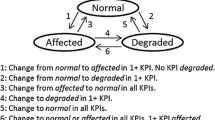Abstract
Self-healing is one of the main functionalities of Self-Organizing-Networks. Among self-healing functions, diagnosis or root cause analysis, consisting of identifying the fault cause in problematic cells, is one of the most complex tasks. Expert systems, such as Fuzzy Logic Controllers or Bayesian Networks, have been previously proposed to implement automatic diagnosis systems in the radio access segment of mobile communication networks. In order to achieve accurate results, these diagnosis systems should contain the knowledge of experienced LTE troubleshooting experts. However, these experts normally have neither the time nor the expertise in artificial intelligence to define the expert system. In this work, we propose a novel knowledge acquisition system that obtains this knowledge in the least possible intrusive way. The proposed method collects the Performance Indicators data from the relevant time intervals together with the expert’s diagnosis and uses them as inputs for a Data Mining algorithm to extract diagnosis rules.











Similar content being viewed by others
References
3GPP. (2012). Telecommunication management; Self-Organizing Networks (SON); Concepts and requirements. Next Generation Mobile Networks (NGMN) Alliance, ts 32.500 edn.
Barco, R., Díez, L., Wille, V., & Lázaro, P. (2009). Automatic diagnosis of mobile communication networks under imprecise parameters. Expert Systems with Applications, 36(1), 489–500.
Barco, R., Lázaro, P., & Muñoz, P. (2012). A unified framework for self-healing in wireless networks. IEEE Communications Magazine, 50, 134–142.
Barco, R., Lázaro, P., Wille, V., Díez, L., & Patel, S. (2009). Knowledge acquisition for diagnosis model in wireless networks. Expert Systems with Applications, 36(3, Part 1), 4745–4752.
Barco, R., Wille, V., Díez, L., & Toril, M. (2010). Learning of model parameters for fault diagnosis in wireless networks. Wireless Networks, 16, 255–271.
Bennacer, L., Ciavaglia, L., Chibani, A., Amirat, Y., & Mellouk, A. (2012). Optimization of fault diagnosis based on the combination of Bayesian Networks and case-based reasoning. In: IEEE Network Operations and Management Symposium (NOMS).
Breysse, D. (2012). Forensic engineering and collapse databases. Proceedings of the Institution of Civil Engineers-Forensic Engineering, 165(2), 63–75.
COMMUNE. (2012). Commune (cognitive network management under uncertainty).
Fayyad, U., & Irani, K. B. (1993). Multi-interval discretization of continuous valued attributes for classification learning (pp. 1022–1027).
Fayyad, U., Piatetsky-Shapiro, G., & Smyth, P. (2003). From Data Mining to knowledge discovery in databases. AI Magazine, 17(3), 37.
Khatib, E., Barco, R., Gómez-Andrades, A., Muñoz, P., & Serrano, I. (2015). Data Mining for fuzzy diagnosis systems in LTE networks. Expert Systems with Applications, 42(21), 7549–7559. doi:10.1016/j.eswa.2015.05.031.
Liinasuo, M., Karvonen, H., Aaltonen, I., Fuentes, B., & Castro, A. (2012). Human operator trust in autonomic functionalities. In Proceedings of the 30th European Conference on Cognitive Ergonomics, ECCE ’12 (pp. 45–51). ACM.
NGMN: (2007). Use cases related to self-organising network, overall description. Next Generation Mobile Networks (NGMN) Alliance, http://www.ngmn.org.
Ramírez-Gallego, S., García, S., Mouriño-Talín, H., Martínez-Rego, D., Bolón-Canedo, V., Alonso-Betanzos, A., et al. (2016). Data discretization: taxonomy and big data challenge. Wiley Interdisciplinary Reviews: Data Mining and Knowledge Discovery, 6(1), 5–21.
Santos, J. P., Alheiro, R., Andrade, L., Caraguay, V., Leonardo, Á., Barona López, L. I., et al. (2016). Selfnet framework self-healing capabilities for 5G mobile networks. Transactions on Emerging Telecommunications Technologies, 27(9), 1225–1232.
SELFNET. (2015). Selfnet project. https://selfnet-5g.eu/.
Szilagyi, P., & Novaczki, S. (2012). An automatic detection and diagnosis framework for mobile communication systems. IEEE Transactions on Network and Service Management, 9(2), 184–197.
Terwel, K., Boot, W., & Nelisse, M. (2014). Structural unsafety revealed by failure databases. Proceedings of the ICE-Forensic Engineering, 167(1), 2014.
Univerself. (2012). Univerself project. http://www.univerself-project.eu/.
Wang, L. X., & Mendel, J. M. (1992). Generating fuzzy rules by learning from examples. IEEE Transactions on Systems, Man and Cybernetics, 22(6), 1414–1427.
Wu, X., Chen, H., Wu, G., Liu, J., Zheng, Q., He, X., et al. (2015). Knowledge engineering with big data. IEEE Intelligent Systems, 30(5), 46–55.
Acknowledgements
This work has been partially funded by Optimi-Ericsson, Junta de Andalucía (Agencia IDEA, Consejería de Ciencia, Innovación y Empresa, Ref. 59288 and Proyecto de Investigación de Excelencia P12-TIC-2905) and ERDF.
Author information
Authors and Affiliations
Corresponding author
Ethics declarations
Conflict of interest
The authors declare that they have no competing interests.
Rights and permissions
About this article
Cite this article
Khatib, E.J., Barco, R., Muñoz, P. et al. Knowledge Acquisition for Fault Management in LTE Networks. Wireless Pers Commun 95, 2895–2914 (2017). https://doi.org/10.1007/s11277-017-3969-x
Published:
Issue Date:
DOI: https://doi.org/10.1007/s11277-017-3969-x




